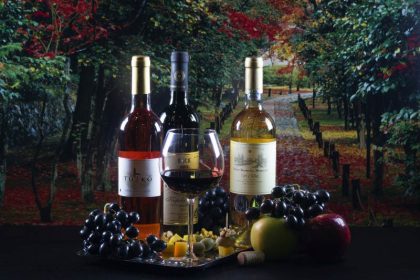

CONTACT US
1052 Budapest, Jane Haining Quay, Dock 11.
Customer support is available daily from 9:00 to 22:00.
Budapest, Jane Haining Quay, Dokk 11, 1052


In Hungary, there are 22 wine regions which all have special geographical, climatic and pedological features. Consequently, the palettes of Hungarian wines are also various and the country has some unique species of grapes, too. The products of the ‘closed’ wine regions receive special protection. There’s one region like this in the country and it’s called ‘Tokaj-Hegyalja’. You can find major plantations of grapes in 558 towns or villages – this is circa 18% of the Hungarian settlements. It’s not surprising that Hungarian wines are loved not only inside the borders but also in foreign countries, and more and more types of wine are exported.
Wines have always had an important role in Hungarian cuisine. Harmony of drink and food is a cardinal aspect, so you should consider some pieces of advice by choosing wines. “Red meat requires red wine, fish and white meat requires white one” – this is a pearl of old wisdom. It can truly help but nowadays you don’t need to strictly satisfy it.
For example, Olaszrizling is a kind of white wine but we can recommend it to both fish soup and beef. So you’d better if you consider the basic taste of wines. For example, if the dish is bitter, bitter wines are forbidden! Naturally, you don’t have to ignore these wines: fatty or salty courses perfectly suit to wines which are rich in tannins!
If you choose wines to desserts, don’t forget that the wine should always be sweeter than the food. Otherwise, you’ll taste the wine bitter. Tokaji and other sweet wines are recommended to desserts, such as one of the famous Hungarian desserts like “Gundel palacsinta”, “Somlói galuska” or the famous Dobos cake. Besides desserts, you can drink it with Foi Gras or Duck made with honey and mustard. Eger Bikaver is an excellent choice for venison or beef. Cheese is a common attendant of wines but finding the ideal pairs is really important. Olaszrizling suits to blue cheese while rosé suits to Camembert.
On the region of Transdanubia, grapes were grown since the ancient Roman times, notedly the reign of Marcus Aurelius emperor. In 1241 the Tatars destroyed nearly all the vineyards. Fortunately, King Béla IV. ordered the peasants to plant new grapevines. The best wine regions such as Sopron, Eger or Tokaj are originated from this age. Until the 18th century, Szerémség was the most famous region. The 20th century wasn’t a good period in the history of Hungarian wines: phylloxera (also known as vine pest) destroyed lots of vineyards, then, after the 2nd world war, the Communist regime caused also several harms because it preferred not the quality but the quantity, so the mass-production. Fortunately, after the end of this regime, vineyards started to develop and nowadays Hungarian wines are famous again. They are acknowledged on international competitions such as VinAgora or Muscats du Monde.
Consuming of wine is the part of the Hungarian culture. If there’s any celebration, two or three types of wine will surely be found on the table. But Hungarians don’t need some really special occasions: on the hot summer eves, they prefer spitzer (‘fröccs’) – which can be made by mixing some wine and sparkling water. It can be really refreshing! In the cuisine, wines aren’t only attendants of dishes – they can be ingredients themselves! For example, red wine can make gravy of Beef stews tastier. White wines can be used in sauces of dishes which are made of chicken, turkey or even mushroom, but it can be the basic ingredient of soups, too. A good wine soup with some vanilla and raisins can be an excellent festal course.

It’s a red cuvée, so it’s made of two or three species of blue grapes but none of them can be dominant. Cadarca, cabernet sauvignon, cabernet franc, merlot, pinot noir, blauburger, harslevelu, Zweigelt, or blue Medoc can be used. Before selling, this wine must be ripened at least for one year in a wooden cask. Some of the best-known producers: Halmosi, Takler, Ribling, or Heimann. It’s rich in alcohol, and you can taste fruity and spicy savor in it.
But why is it called ’bikavér’? There’s a probably not true but interesting legend about it. During a great Turkish siege of Eger in 1552, the captain of the fortress gave this wine to his soldiers. The Turkish saw that Hungarian soldiers regained strength due to the drink, and also saw some red fluid trickling on the walls. They were superstitious and thought that was truly blood of a bull.
Probably this is the most famous Hungarian wine! ‘The wine of kings and the king of wines’, as Louis XIV, the French king said. Tokaj-Hegyalja wine region is located in the north-eastern part of the country. Six species of grapes (Furmint, Hárslevelű, Kabar, Kövérszőlő, Yellow Muscat, and Zeta) are grown here; all of them are the materials of white wines. ‘Tokaji’ was created in 1630 by a priest in the palatial court of Transylvania; he was called Laczkó Máté Szepsi. A phenomenon called noble rot has a significant role in the birth of this wine; this is caused by a special fungus (Botrytis cinera). ‘Tokaji’ is best delicious at 10-12°C.
This species of grapes is a material of white wine, and it came from France in the 19th century. After the big vine pest, destroyed vineyards were replaced by it, and this species became fast popular. There are big vineyards on the Saint-Georges Hill and in Csopak – and Olaszrizling form these regions are more successful than in its original country!